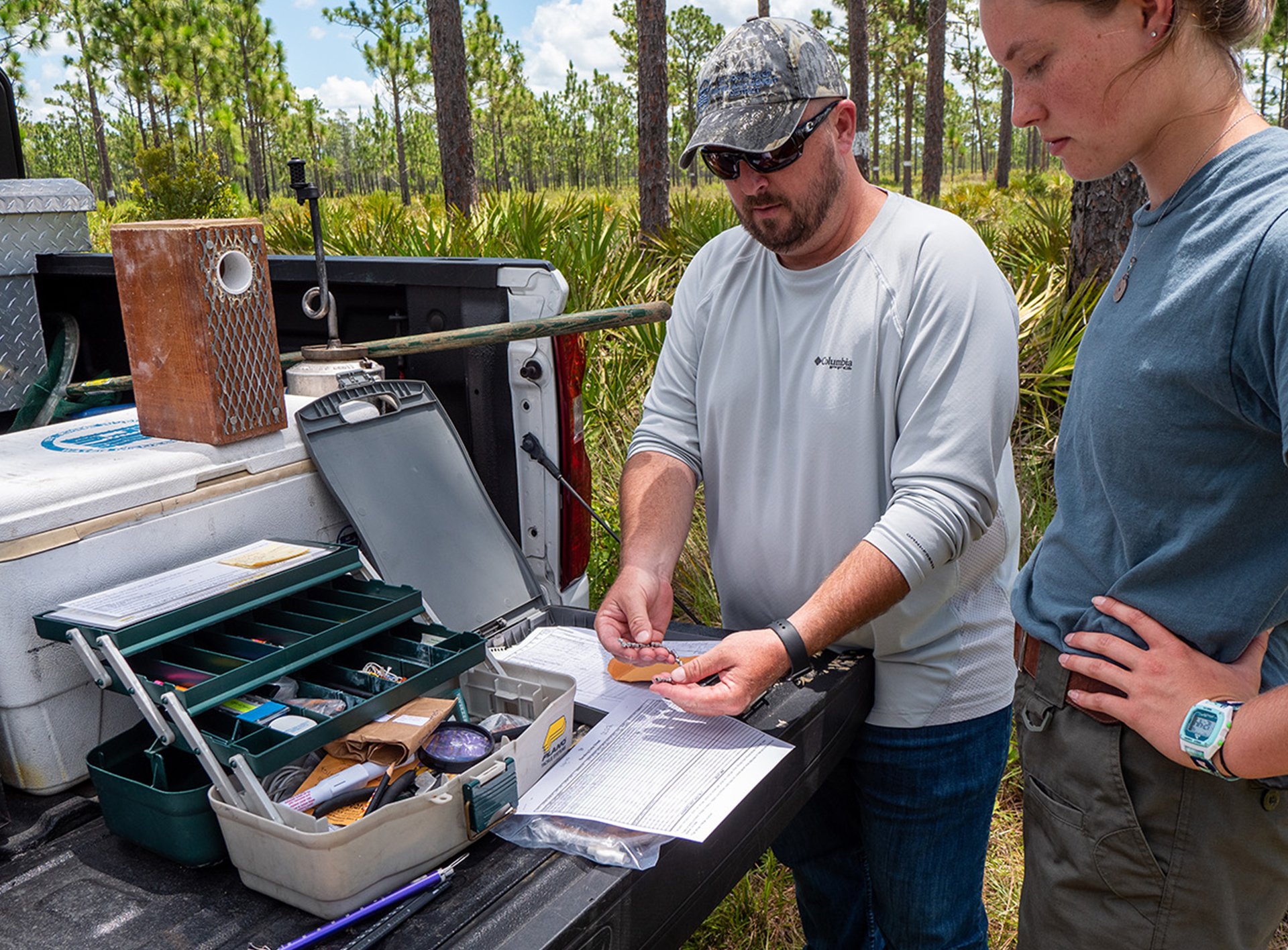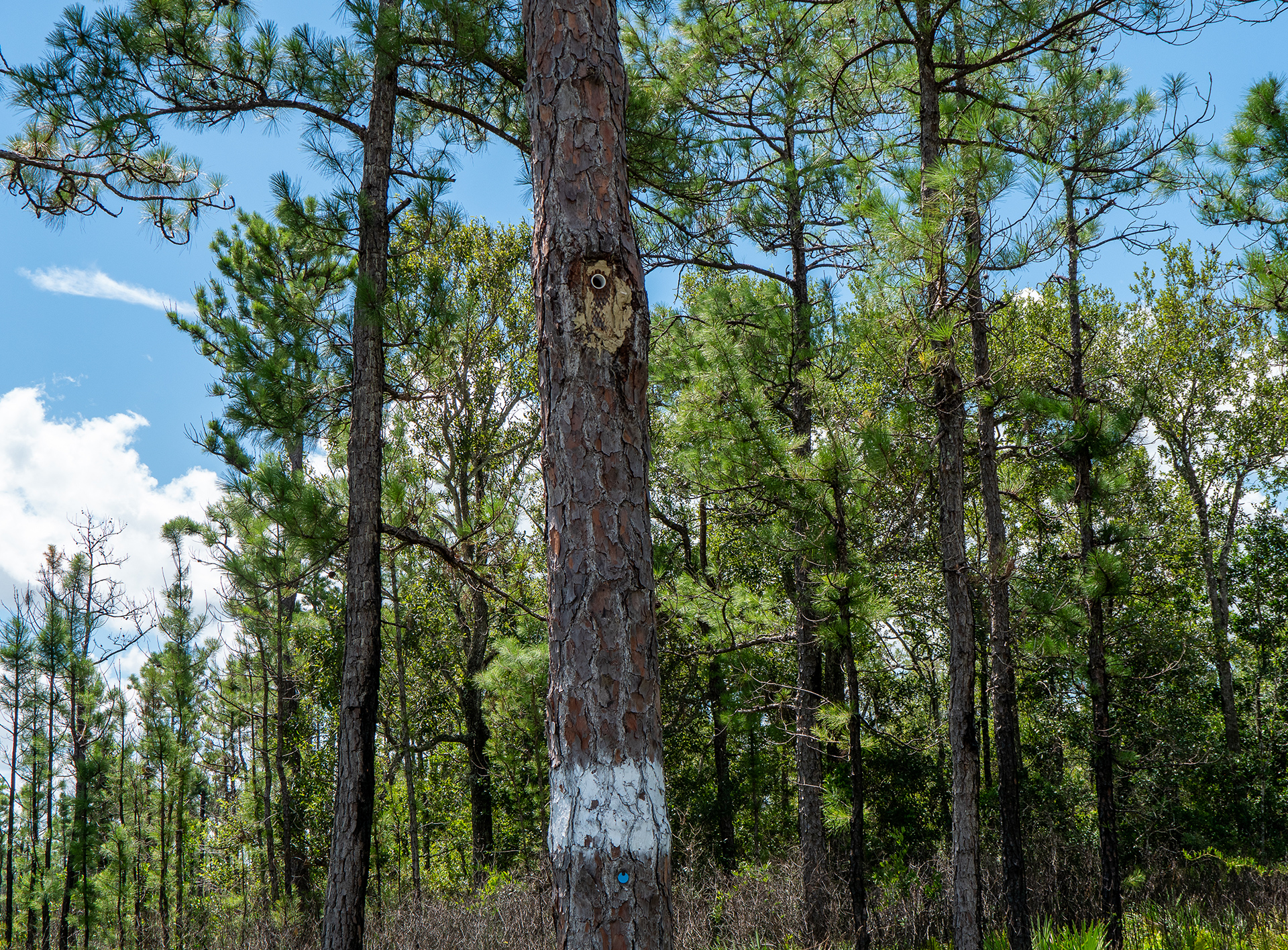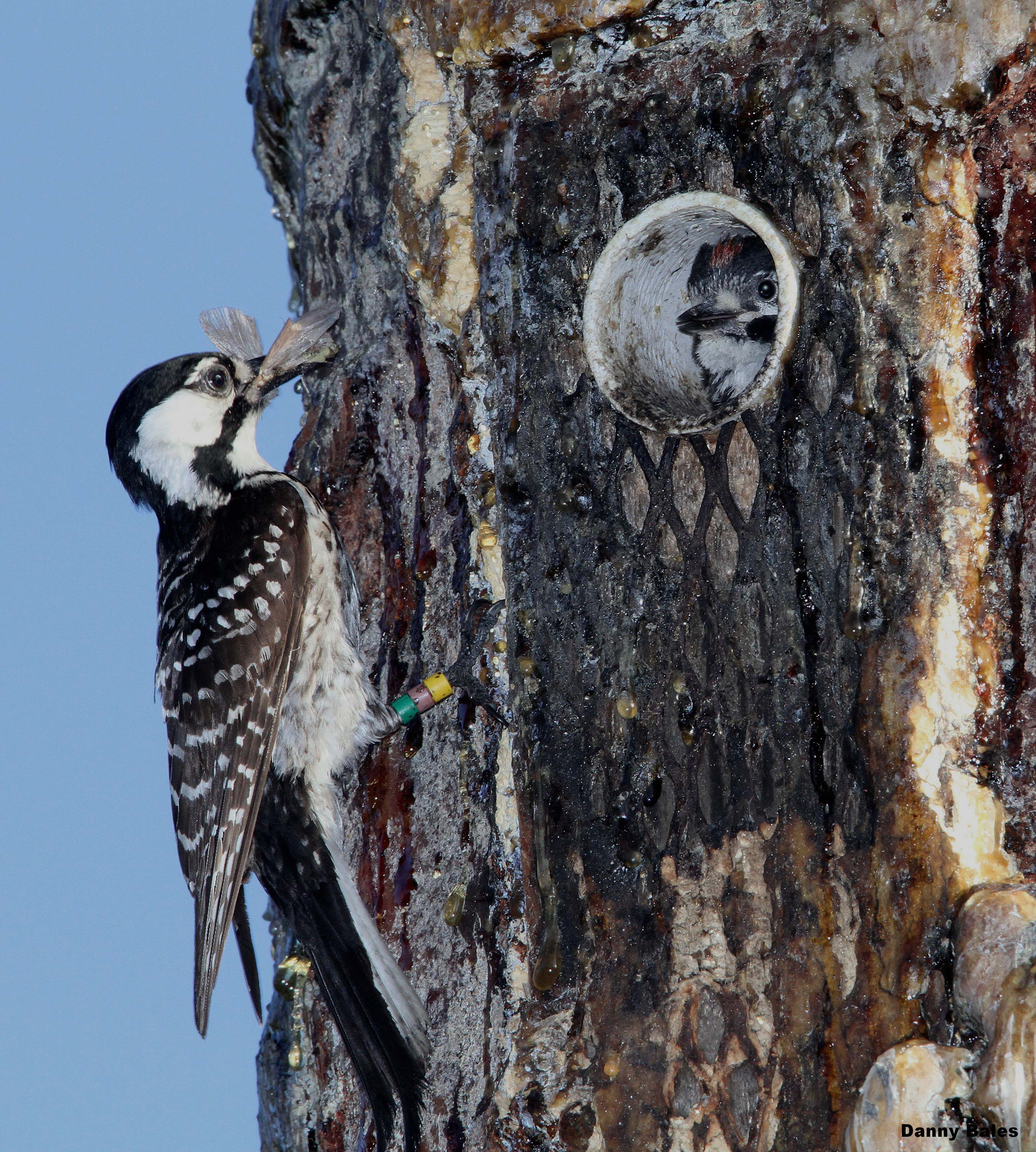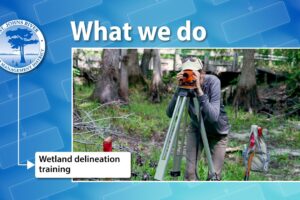Providing habitat for red-cockaded woodpeckers at Hal Scott results in ecosystem-wide benefits
Aug. 18, 2022
District Land Manager Graham Williams works with intern Katie Johnsen as part of work to monitor woodpecker families living on District conservation lands.
Imagine knowing so much about a population of birds that you can recognize when a new one shows up. That’s a day in the life for Graham Williams, a land manager for the St. Johns River Water Management District’s Hal Scott Regional Preserve and Park.
Hal Scott is a haven to forest birds in central Florida. This remnant of mature longleaf pine forest is home to the endangered red-cockaded woodpecker and other species. Not long ago, Williams was checking on young woodpeckers that had recently left their nests when he saw an interloper – a woodpecker lacking the leg bands that identify all birds in the Hal Scott population.
Intensive, hands-on management efforts throughout the bird’s range have kept these woodpeckers from going extinct. An unbanded mystery bird is a rarity. But it’s a good sign that it showed up here. These black and white woodpeckers have specific housing needs, and their homes are in short supply. Red-cockaded woodpeckers are the only woodpeckers in North America that build nests in live pine trees — specifically they prefer mature, 60+ year old longleaf pines.
At one time the woodpeckers and their habitat were plentiful. Longleaf pine forests stretched from east Texas to Virginia and throughout most of northern and central Florida. These once vast forests have been whittled down to a patchwork of what they once were: logged for wood products and cleared for development and agriculture. Today, only about 3 percent of the original longleaf pine forest remains. Habitat loss led to the listing of the red-cockaded woodpeckers as a protected species in the 1970s.
A large part of Hal Scott Preserve provides habitat for the red-cockaded woodpecker. The District manages the approximately 9,000-acre preserve, which is just southeast of Orlando and is an island of mature longleaf pine forest in a growing sea of subdivisions and development. Today, this former cattle ranch is home to around 40–50 red-cockaded woodpeckers.
Williams looks after the forest, as well as the resident woodpeckers. These birds are relatively long-lived; the oldest at Hal Scott lived to be at least 13 years old. Red-cockaded woodpeckers are social, living in a family group of three to four birds, sometimes up to seven, with each bird claiming its own cavity for sleeping. As a family group they are territorial. “Each individual family group defends somewhere between 100–200-acres of territory,” Williams explains. They avoid dense brushy forest, perhaps because it makes it harder to spot predators, but they need enough trees to forage for food (primarily arthropods such as insects). If crowded, the birds start fighting with neighboring family groups to defend their cavity trees and food supply.
Each spring, the breeding male in each family group prepares his cavity tree — what he deems as the “best” house — for nesting and courts his mate into laying her eggs in his tree. The male does much of the incubation, getting help from other birds, generally the non-breeding sons from previous generations. Together this family group takes turns incubating and feeding the clutch of two to four, from the time the female lays the eggs until the young are ready to leave the nest, about a month after hatching.
Often his nesting cavity will be reused year after year for the life of the breeding pair and sometimes even longer when a new breeder takes over the clan. A good nesting cavity is a valuable commodity to a red-cockaded woodpecker. New nest cavities can take years to create, as the woodpeckers must break through a thick layer of bark to access the heartwood interior affected by a heart-rot fungus. Fungus-softened wood is easier to excavate into a cavity, but trees must be quite old before they become afflicted with heart-rot. At Hal Scott, the woodpeckers can choose a prefabricated home Williams and other District biologists provide. These artificial nest boxes are installed in pine trees in hopes of helping these woodpeckers with their housing issues. It seems to work. Of the 10 nests built this year, three were in these artificial nest boxes.
Prefabricated or custom built, the woodpeckers still need to secure their nest. Predators abound and snakes will climb up the tree and eat the adults, eggs and young. The woodpeckers peck into the tree around their nests, creating sticky resin wells that drip sap down the trunk, deterring predators from climbing up the trunk of the tree. Trees with active nests glisten with pine pitch. Williams adds another layer of protection, wrapping the base of the tree in tinfoil if he knows a nest is occupied with eggs or nestlings because they are especially vulnerable to predation. The tinfoil makes the trunk too slippery to be easily climbed by snakes or other small nest predators.
In a small population like at Hal Scott, District biologists try to track every individual red-cockaded woodpecker. When chicks are about a week old, biologists use ladders to climb the tree, remove the baby birds, measure, weigh and band them with numbered and color-coded leg bands, then return them to their nests. Once the chicks have left the nest, Williams and his team track the birds to figure out the sex of each chick. For a few weeks after leaving the nest, the male sports an obvious patch of red feathers on the top of his head. If Williams misses this window, his job becomes more difficult as the only visible difference between mature males and females is that males have a tiny ribbon (a cockade is a hat ribbon) of red feathers on the side of their heads. Since this marking can be so hard to see, sometimes biologists will capture the bird in a net, checking for the ribbon of feathers close-up.
When not capturing birds, Williams keeps up the neighborhood. The longleaf pine forest is a fire-dependent ecosystem. Regular fires don’t harm the pines, thanks to thick bark and a self-limbing habit (they drop lower branches), that keeps the fire from reaching the crown of the tree. Williams also back-burns to remove vegetation around nesting trees before starting low-intensity burns to remove understory hardwood growth. This reduces the likelihood that lightning-caused fires will burn out of control and maintains the open park-like forest where the red-cockaded woodpeckers feel safe.
Williams still hasn’t determined where the mystery unbanded bird came from. Because birds don’t know property boundaries, it could have come from another population offsite.
Throughout the southeast, protected public lands, such as the District’s conservation areas, provide most of the habitat for the red-cockaded woodpecker. Florida is home to approximately 25 percent of the population and the Florida Fish and Wildlife Conservation Commission (FWC) coordinates the statewide conservation efforts with land managers like Williams. This hands-on management has worked throughout the country. The population in the U.S. grew from 4,694 in 1993 to 8,200 by 2020. At Hal Scott the population is stable with about 10 breeding groups. District biologists estimate this number reflects the maximum sustainable population at the preserve. But over time, this could change: as young trees mature to the 60–70 year age, the population of woodpeckers could grow.
There’s inherent fragility in these small populations. A heavy hurricane could flood cavities and destroy nesting trees, as it did in 2004 when four hurricanes swept across central Florida in six weeks. In 2005, only two pairs of birds nested at Hal Scott. A network of state and federal agencies stepped in, relocating birds from other larger populations, helping the Hal Scott population recover to what it is today. Given the increasing likelihood of hurricanes, wildfires, droughts and other natural disasters, the future of the red-cockaded woodpecker is tied to continued efforts to protect both the birds and their habitat.
“Red-cockaded woodpeckers really are a keystone species for management,” says Williams. “If we manage for them, all the other species that live here are going to do well.” This includes other pine forest specialist birds such as brown-headed nuthatches and Bachman’s sparrow.
Learn more about the Hal Scott Regional Preserve and Park and the District’s continued land management efforts on the District’s website at www.sjrwmd.com/lands/recreation/hal-scott.









